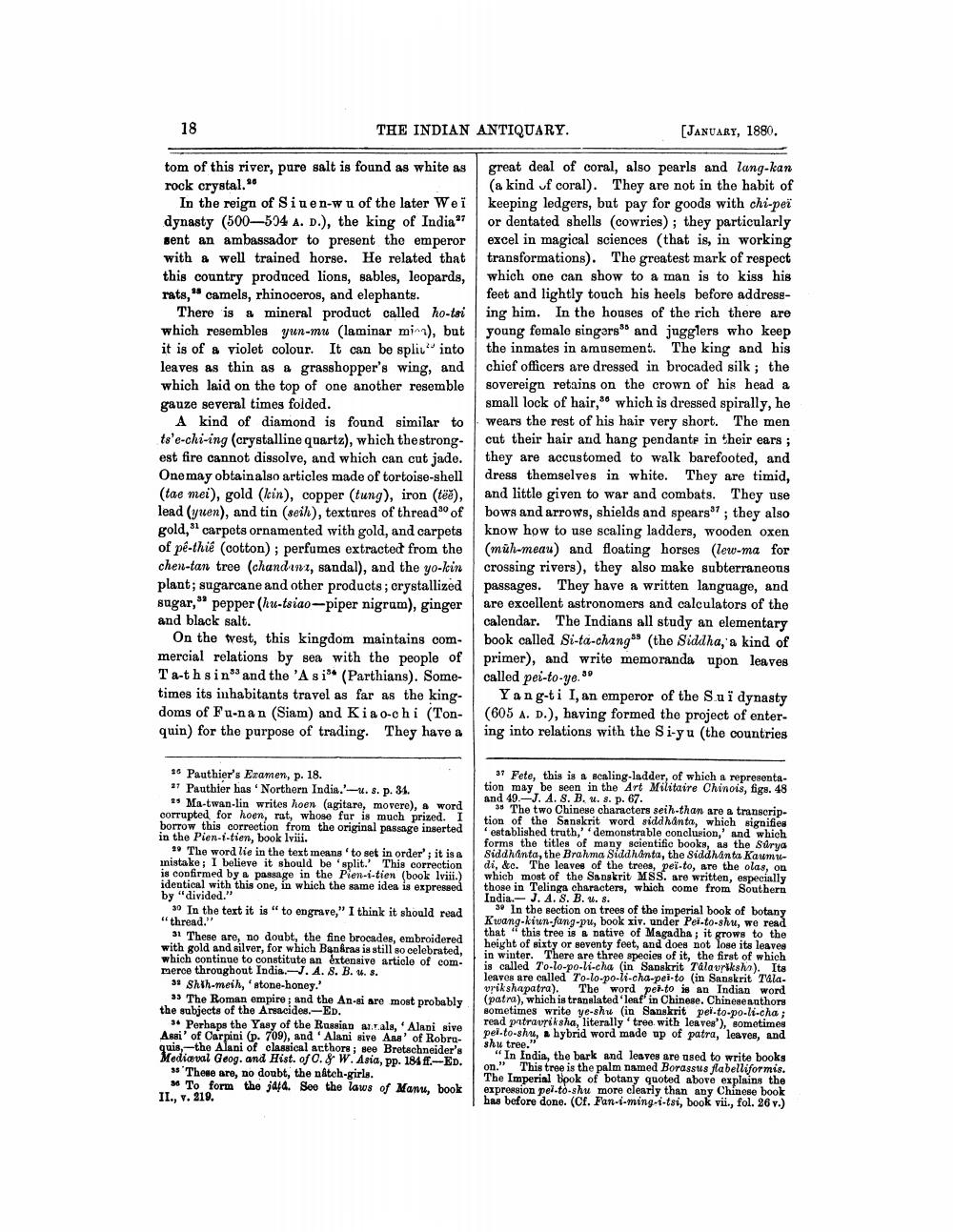________________
18
THE INDIAN ANTIQUARY.
tom of this river, pure salt is found as white as rock crystal."
In the reign of Siuen-w u of the later Wei dynasty (500-504 A. D.), the king of India" sent an ambassador to present the emperor with a well trained horse. He related that this country produced lions, sables, leopards, rats," camels, rhinoceros, and elephants.
There is a mineral product called ho-tsi which resembles yun-mu (laminar min), but it is of a violet colour. It can be split into leaves as thin as a grasshopper's wing, and which laid on the top of one another resemble gauze several times folded.
A kind of diamond is found similar to ts'e-chi-ing (crystalline quartz), which the strongest fire cannot dissolve, and which can cut jade. One may obtainalso articles made of tortoise-shell (tae mei), gold (kin), copper (tung), iron (tee), lead (yuen), and tin (seih), textures of thread of gold, carpets ornamented with gold, and carpets of pê-thie (cotton); perfumes extracted from the chen-tan tree (chandant, sandal), and the yo-kin plant; sugarcane and other products; crystallized sugar," pepper (hu-tsiao-piper nigrum), ginger
and black salt.
On the west, this kingdom maintains commercial relations by sea with the people of Ta-thsin and the 'A s is (Parthians). Sometimes its inhabitants travel as far as the kingdoms of Fu-nan (Siam) and Kiao-chi (Tonquin) for the purpose of trading. They have a
26 Pauthier's Examen, p. 18.
27 Pauthier has 'Northern India.'-u. s. p. 34.
25 Ma-twan-lin writes hoen (agitare, movere), a word corrupted for hoen, rat, whose fur is much prized. I borrow this correction from the original passage inserted in the Pien-i-tien, book lviii.
29 The word lie in the text means 'to set in order'; it is a inistake; I believe it should be 'split.' This correction is confirmed by a passage in the Pien-i-tien (book lviii.) identical with this one, in which the same idea is expressed by "divided."
30 In the text it is " to engrave," I think it should read
"thread."
31 These are, no doubt, the fine brocades, embroidered with gold and silver, for which Banaras is still so celebrated, which continue to constitute an extensive article of commerce throughout India.-J. A. S. B. u. s.
32 Shih-meih, stone-honey."
33 The Roman empire; and the An-si are most probably the subjects of the Arsacides.-ED.
3 Perhaps the Yasy of the Russian arrals, Alani sive Assi' of Carpini (p. 709), and Alani sive Aas' of Robruquis, the Alani of classical authors; see Bretschneider's Mediaval Geog. and Hist. of C. & W. Asia, pp. 184 ff.-ED. 35 These are, no doubt, the nåtch-girls.
36 To form the jaid. See the laws of Manu, book II., v. 219.
[JANUARY, 1880.
36
great deal of coral, also pearls and lang-kan (a kind of coral). They are not in the habit of keeping ledgers, but pay for goods with chi-peï or dentated shells (cowries); they particularly excel in magical sciences (that is, in working transformations). The greatest mark of respect which one can show to a man is to kiss his feet and lightly touch his heels before addressing him. In the houses of the rich there are young female singers and jugglers who keep the inmates in amusement. The king and his chief officers are dressed in brocaded silk; the sovereign retains on the crown of his head a small lock of hair, which is dressed spirally, he wears the rest of his hair very short. The men cut their hair and hang pendants in their ears; they are accustomed to walk barefooted, and dress themselves in white. They are timid, and little given to war and combats. They use bows and arrows, shields and spears37; they also know how to use scaling ladders, wooden oxen (müh-meau) and floating horses (lew-ma for crossing rivers), they also make subterraneous passages. They have a written language, and are excellent astronomers and calculators of the calendar. The Indians all study an elementary book called Si-ta-chang (the Siddha, a kind of primer), and write memoranda upon leaves called pei-to-ye."
Yang-ti I, an emperor of the Suï dynasty (605 A. D.), having formed the project of entering into relations with the Si-yu (the countries
37 Fete, this is a scaling-ladder, of which a representation may be seen in the Art Militaire Chinois, figs. 48 and 49.-J. A. S. B. u. s. p. 67.
4
38 The two Chinese characters seih-than are a transcription of the Sanskrit word siddhanta, which signifies established truth,' 'demonstrable conclusion,' and which forms the titles of many scientific books, as the Surya Siddhanta, the Brahma Siddhanta, the Siddhanta Kaumu di, &c. The leaves of the trees, pei-to, are the olas, on which most of the Sanskrit MSS. are written, especially those in Telinga characters, which come from Southern India. J. A. S. B. u. s.
39 In the section on trees of the imperial book of botany Kwang-kiun-fang-pu, book xiv. under Pei-to-shu, we read that this tree is a native of Magadha; it grows to the height of sixty or seventy feet, and does not lose its leaves in winter. There are three species of it, the first of which is called To-lo-po-li-cha (in Sanskrit Talavriksha). Its leaves are called To-lo-po-li-cha-pei-to (in Sanskrit Tálavrikshapatra). The word pei-to is an Indian word (patra), which is translated leaf in Chinese. Chinese authors sometimes write ye-shu (in Sanskrit pei-to-po-li-cha; read patravriksha, literally tree with leaves'), sometimes pei-to-shu, a hybrid word made up of patra, leaves, and shu tree."
on."
"In India, the bark and leaves are used to write books This tree is the palm named Borassus flabelliformis. The Imperial book of botany quoted above explains the expression pel-to-shu more clearly than any Chinese book has before done. (Cf. Fan-i-ming-i-tsi, book vii., fol. 26 v.)




